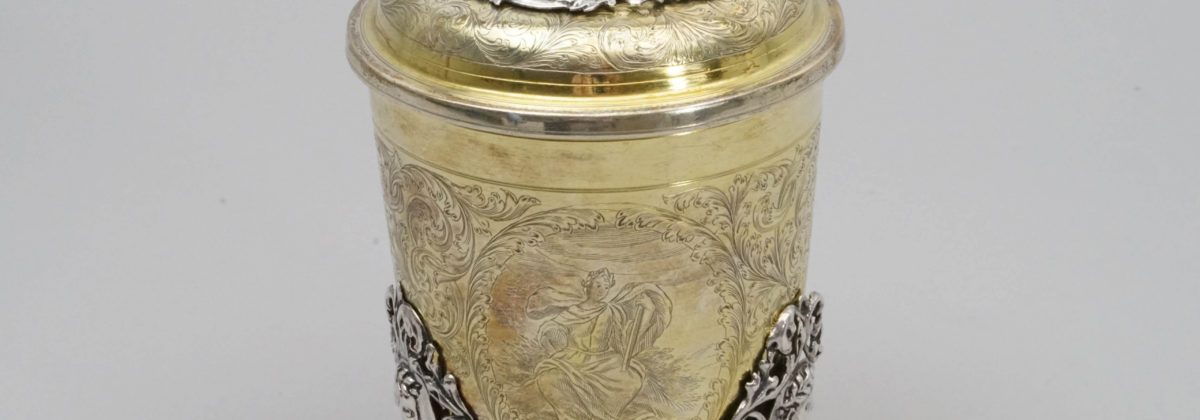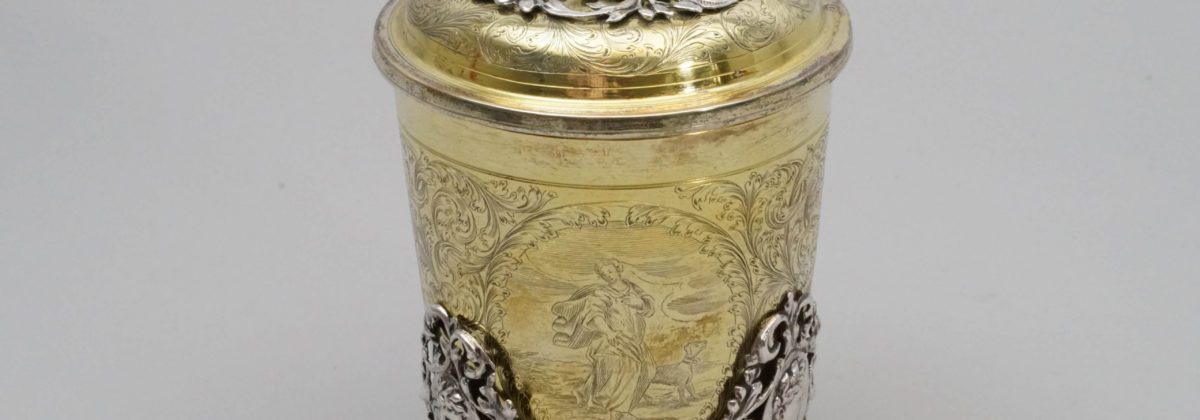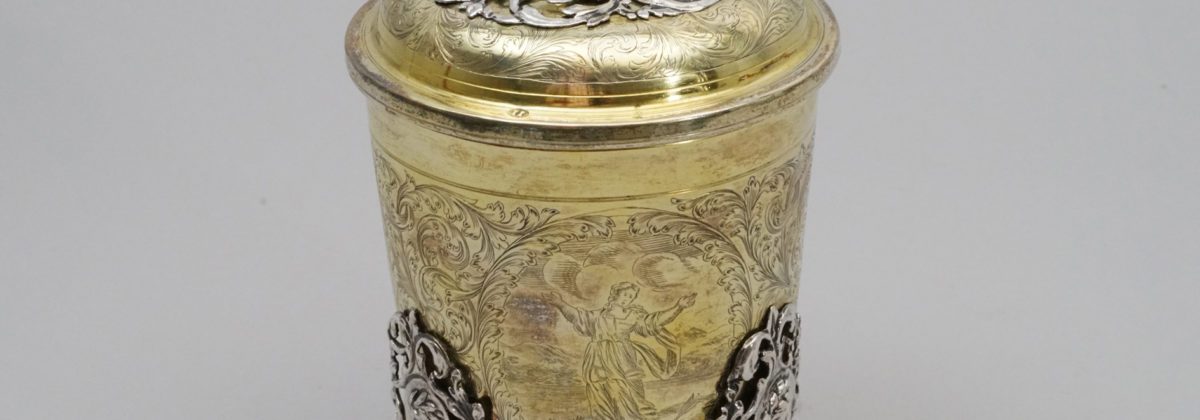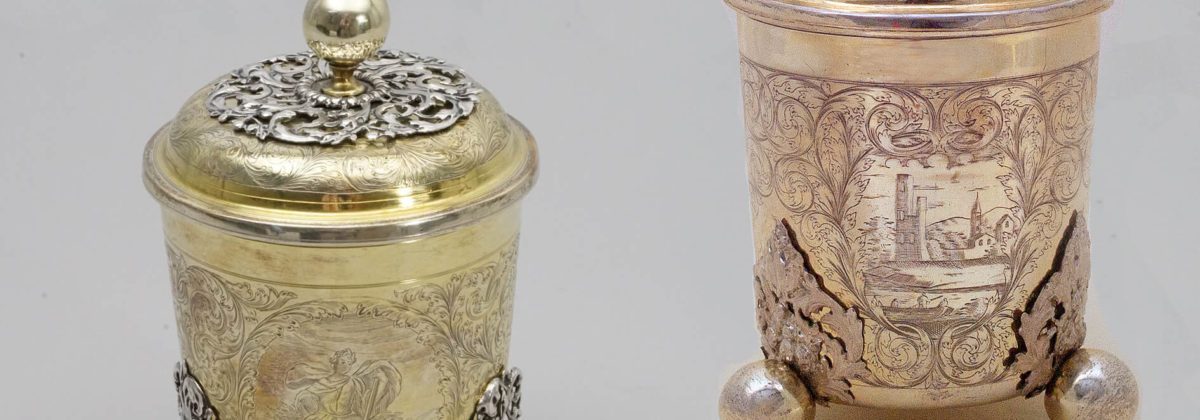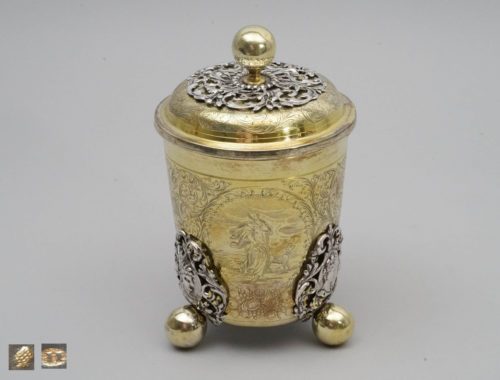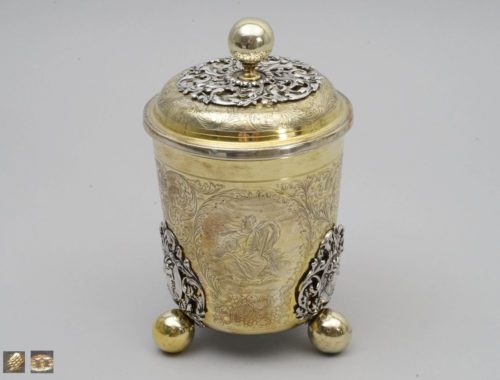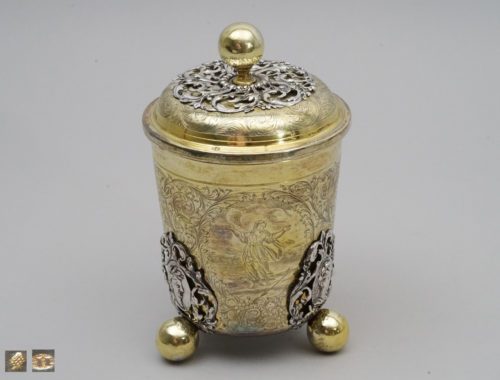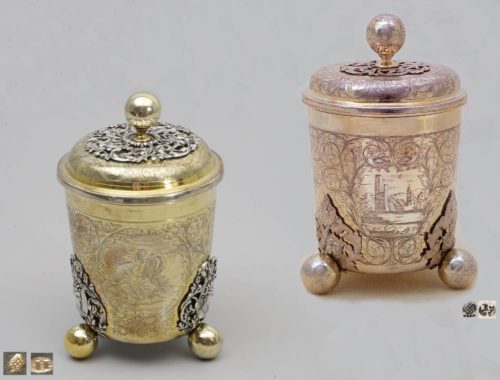Objektnummer
Augsburg 1697-1699
Johann Jebenz
City hallmark: “Pyr” for Augsburg, (BZ Seling No. 1160)?
Maker’s mark: “II” for Johann Jebenz (born 1661, died 1737) Master 1694 – 1708 (MZ Seling No. 1887c)
Silver, chased, cast, engraved, hallmarked, partially gilt
Height: 17 cm (6.69 in.); Weight: 424 g
Detailed Description
Detailed information
Almost at the same time as the silver-gilt Augsburg spherical foot beaker with artistically engraved landscapes by Johann Christoph I Treffler # 123, this lavishly engraved lidded beaker based on three dainty baubles was created by the Augsburg goldsmith Johann Jebenz.
The completely gilded object is adorned – in an exciting contrast – mounted silver-shimmering imperial portrait medallions. A tendril cuff formed by rolled up silver leaves surrounds the lid, which is crowned by a spherical knob.
Three allegorical representations dominate the rising bowl of the vessel. They are framed by tendril cartouches that seem to grow out of fruit still-lifes. Depicting three female allegories that aim puzzle and intrigue: It is a seated female figure – probably a poet – crowned by a laurel wreath, whose robe frames her shoulders in a strikingly moving manner. She lowers her gaze to an extinguished torch propped up on her knee. Another standing female allegory, above which a mountain of clouds towers, raises both hands helplessly with a frightened expression on her face, while an arrow pointing diagonally into the picture at the still life of fruit raises questions. The third allegory shows a standing woman in a fluttering robe, who turns her head to one side, while a dog standing next to her (always associated with fidelity) turns completely away from her in the other direction. Presumably, this is the opposite of the representations of loyalty, love and wisdom or enlightenment – they offer inspiration for a game of thoughts that can be perfectly harmonized with the thought of Carpe Diem and the vanitas motif in Baroque art.
The spandrels between the allegories are adorned with herbaceous intertwined, twisted and finely engraved tufts of acanthus tendrils, which are strongly reminiscent of Martin Schongauer’s copperplate engraving “Cross filling from a tuft of grass growing” from the second half of the 15th century.
It is highly likely ebenz also used graphic templates for the silver medallions preserved in their original mounting: his portraits of the emperors are reminiscent of Hubert Goltzius” portraits of the “classical emperors” which are highlighted by oversized laurel wreaths, the attachment of which is emphasised by a fluttering ribbon in the neck and those of Coppens van Diest, Gillis in 1557 and published under the name “Vivae Omnium Fere Imperatorum Imagines”. Johann Jebens used these templates several times in his objects. He engraves the representation of a Roman emperor – with a conspicuous spike / ray crown – on a tumbler, which is also clearly to be found in Goltzius. The use of coin portraits or ancient portraits, landscapes or allegories surrounded by tendrils was widespread and very popular around 1700.
Maker:
The Augsburg goldsmith Johann Jebenz, born 1661, master 1694-1708, died in 1737. Jebenz has numerous preserved goldsmith’s work: plates, bowls, beakers, a goblet, a communion jug and candlesticks are distributed in numerous large arts and crafts museums in Europe. His works can be found in the Moscow Kremlin, the Museum of Applied Arts in Frankfurt, the Victoria & Albert Museum in London, in the Livrustkammaren of the Palace in Stockholm and in the State Hermitage in St. Petersburg.
Literature
Hernmarck, Karl, The Art of European Gold- and Silversmiths from 1450-1830, Munich 1978, p. 80
Pechstein, Klaus (ed.), Treasures of German Goldsmithing from 1500 to 1920 from the Germanisches Nationalmuseum Nürnberg, Berlin 1992, pp. 190-191, cat. No. 67; P. 193, cat. No. 70 (for Augsburg ball-foot cups with lids, engraved acanthus tendrils and medallions)


